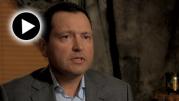At the TIA 2015 Network of the Future Conference, Sandro Tavares, Head of Marketing, Mobile Core at Nokia Networks, tells TIA NOW why network agility - to scale and innovate - is the primary driver for Cloud technologies.
TIA 2015 executive interview
All TIA 2015 executive interview Videos:
-
-
Rod Naphan, Chief Technology Officer at Fujitsu Network Communications tells TIA NOW how automated networks of the future will change the paradigm of service delivery.
-
Carol Politi, CEO of TRX Systems, tells TIA NOW why we no longer will lose our GPS location as we move indoors from outdoors. New technologies that deliver location and mapping indoors are allowing us to deliver new services. TRX Systems was the runner up at the recent TIA Startup Competition.
-
Tal Bakish, Chief Executive Officer of VocalZoom, tells TIA NOW why noise reduction technologies have a clear business case and a bright future. VocalZoom was the winner of the TIA Startup Competition at TIA 2015 in Dallas, TX.
-
Stephan Gatien, Global Vice President of Telco and Mobility Solutions at SAP tells TIA NOW why market saturation and declining ARPU are two areas that are clearly a growing challenge. However, connecting telcos with verticals like automotive, healthcare and utilities will enable operators to create new revenue streams and services.
-
Vicky Obenshain, Vice President of Wireless Strategy at Panasonic Solutions Company, told TIA NOW why the Internet of Things is permeating a variety of applications and solutions. From connected cars to connected aircrafts, Panasonic understands that there is a consequence for failure, thus their products must work.
-
Andrew Coward, Vice President of Service Provider Strategy at Brocade, tells TIA NOW how the New IP can further evolve in the carrier ecosystem. From OpenStack and OpenDaylight to new business paradigms, the New IP encompasses telecom as we know it today and the future of virtualized networks.
-
As mobile data services are expected to grow sevenfold in the next three years, MNOs are eager to figure out how to monetize those services with ingenuity and reliability. At TIA 2015, Amit Tiwari, Vice President of Strategic Alliances and Systems Engineering at Affirmed Networks, spoke with TIA NOW about the services that create opportunity, supported by NFV technologies.
-
Tim Nixon, Executive Director and Chief Technology Officer of Applications Delivery and Global Connected Customer Experience at General Motors, spoke to TIA NOW about GM’s move towards in vehicle Wi-Fi and 4G LTE, to enhance vehicular communications services.
-
At TIA 2015, Sanjay Bhatia, Vice President of Solutions Marketing and Strategy at GENBAND sat with TIA NOW to talk about the business case behind NFV. GENBAND focuses on real-time communications (RTC) technologies that rely on software-centric networks.
-
At TIA 2015, Chris Rivera, Managing Director and CTO of the America’s Service Provider and Web Group at Cisco, tells TIA NOW how Intercloud fits into the ecosystem. Rivera says connecting public, private and hybrid clouds will be integral for the future of the network.
-
At TIA 2015, Tom Marcin, Vice President of Operations at Henkels and McCoy spoke to TIA NOW about why carriers are asking for small cell and DAS based technologies. He adds that enterprise customers are asking for PON technologies to transform the services they are able to provide.
-
Paul Obsitnik, Vice President of Service Provider Marketing at Juniper Networks, tells TIA NOW about the drivers for NFV for operators and enterprises. Obsitnik talks about how NFV is maturing as new approaches like DevOps becomes prevalent by using the right tool for the right solution.
-
At TIA 2015, Dr. Brenda Connor, Strategic Client Engagement Partner of Service Enablement and M2M at Ericsson, tells TIA NOW why the adoption of M2M technologies has sped up in recent years. Dr. Connor talks about the importance of advancement in networking, public policy and an open information ecosystem.
-
Tom Tighe, EVP of Sales and Marketing at Power & Tel talks with TIA NOW about how distribution and logistics companies are becoming more strategic through optimizing the supply chain, to create new revenue streams for customers.















